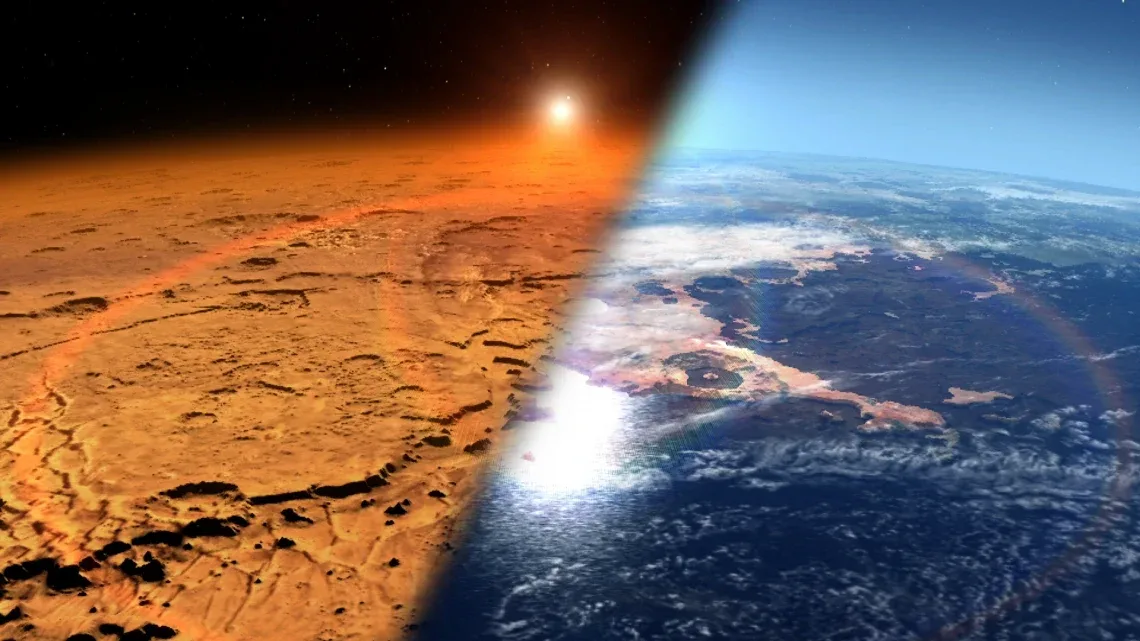Understanding the Climate Divergence Between Earth and Mars
For many years, scientists have been intrigued by the stark differences between Earth and Mars. Both planets began with similar elements—rocky surfaces, carbon, water, and sunlight—but their evolutionary paths have diverged significantly. Earth has remained warm and habitable, while Mars has become a cold and dry desert. A recent study led by Edwin Kite from the University of Chicago offers an insightful explanation for this divergence.
The study, published in the journal Nature, builds upon findings from NASA’s Curiosity rover, which discovered carbonate-rich rocks on Mars’ surface. These rocks tell a story of a planet that once had liquid water but couldn’t sustain it for long. The research suggests that Mars experienced brief wet periods when the sun’s brightness increased, melting ice and allowing water to flow. However, as the water moved across the Martian soil, it absorbed carbon dioxide from the atmosphere, forming carbonates that locked the gas into rock. This process reduced greenhouse gases, cooling the planet and ending the water flow.
Short Bursts of Warmth, Long Ages of Cold
Mars’ history is marked by ancient riverbeds and lake basins, indicating that liquid water once flowed freely. These wet periods came and went over billions of years. According to Kite and his team, each warm spell began with the sun’s increasing brightness, which melted ice or snow, allowing water to run across the surface. However, the same process that helped create these conditions also led to their demise.
On Earth, carbon is cycled through volcanic eruptions and weathering processes, maintaining a stable climate. In contrast, Mars lacks significant volcanic activity, making it difficult to replenish lost carbon. As a result, the planet could not sustain its greenhouse effect, leading to long periods of cold and dryness.
The Mystery of Mars’ Missing Carbon
One of the long-standing mysteries in planetary science is where Mars’ missing carbon went. To support liquid water in the past, the planet must have had a much thicker atmosphere. Researchers have searched for carbonate rocks that would show the gas was trapped underground. Initial missions found little evidence, but the Curiosity rover’s exploration of Mount Sharp in Gale Crater changed this.
The rover discovered high levels of hidden carbonates, some containing 5 to 11 percent by weight. These findings suggest that carbon was buried deep within Martian rock, providing proof of a thick atmosphere that once existed. Benjamin Tutolo, a coauthor of the study, emphasized the importance of ground-based measurements in understanding planetary habitability.
Mars vs. Earth: A Delicate Balance
Earth’s climate stability over 3.5 billion years relies on a balance between carbon cycling in the atmosphere and the planet’s crust. Volcanic eruptions release carbon, while weathering and sedimentation draw it in, creating a feedback loop that maintains a mild climate. Mars, however, appears to have a similar cycle but with a critical flaw. As the sun brightened over time, brief periods of warmth triggered carbonate formation, but without volcanic activity to return carbon, each warming phase was short-lived.
The team’s models suggest that Mars experienced liquid water for only short spans, separated by gaps as long as 100 million years. These long dry spells would have made it nearly impossible for life to take hold or survive.
Tracing Mars’ Climate with Rocks
The Curiosity rover has been exploring Gale Crater, one of Mars’ most diverse sedimentary sites. It has drilled five samples rich in carbonate, spanning nearly 200 meters of rock layers. Some of these rocks were even displaced from higher up the mountain, suggesting carbonate-rich zones may extend farther. The researchers calculated that this carbonate formation likely pulled a significant amount of CO₂ from the air, explaining the planet’s thin atmosphere today.
Similar carbonate-rich rocks have been found in Jezero Crater, where NASA’s Perseverance rover is active. These rocks, likely formed along ancient lakeshores, support the idea that Mars’ sedimentary rocks played a major role in its loss of habitability.
Mars’ Patchy Oases and Chaotic Orbits
Kite’s team used a detailed model to simulate how Mars’ climate changed over billions of years. The model included chaotic shifts in the planet’s orbit, carbonate formation, and carbon loss to space. Their results showed that warm phases were patchy, not global. Snowmelt or shallow groundwater might have fed small oases, but most of the planet stayed dry.
The records in Gale Crater suggest liquid water appeared intermittently, sometimes surprisingly late—up to half a billion years ago. These brief episodes likely produced the carbonate rocks now found in Curiosity’s drill samples. The model shows that every time conditions allowed water, they also enabled carbonate formation, which quickly shut down the greenhouse effect. The atmosphere would then shrink back to a thin, dry shell—too weak to hold liquid water.
A New Way to Understand Habitability
This new research reshapes our understanding of Mars’ past and raises questions about what makes planets habitable. Earth may seem lucky, but its long-term climate stability depends on a delicate carbon balance—one that Mars lost early in its history. With ongoing missions like Curiosity and Perseverance, and data from orbiting spacecraft, scientists are piecing together a clearer story. Mars didn’t just lose its habitability by accident; it was wired to become a desert from the start.
Kite and his colleagues believe the current findings offer a testable model, not just a theory. Future missions can look for more carbonate deposits to confirm whether this self-limiting climate pattern holds across the planet. For now, the story told by Mars’ rocks offers a sobering lesson: even when a planet starts off with the right ingredients, it might still end up lifeless if it can’t maintain the delicate balance that life needs.







